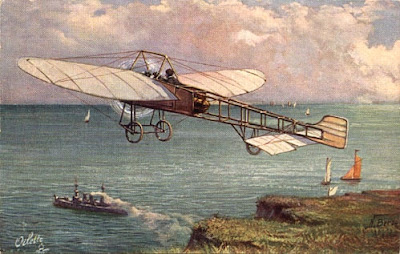I've always been enchanted by the early days of flight. I read Nordhoff & Hall's Falcons of France and watched the films, Those Magnificent Men in Their Flying Machines and The Blue Max on the big screen as a boy. When I finished graduate school in 2001 I devoted several years to playing the WWI flight sim, Red Baron 3D , and reading all about those wonderful winged chariots and the men who dared to fly them.
Early flight was a popular subject for posters, postcards and cigarette cards. In-flight photography was in its infancy, and miniature paintings were often used. Most of these images are from Rosebud's WWI and Early Aviation Image Archive. They are all, to the best of Rosebud's knowledge, in the public domain. I've had them on my hard drive for years. I actually thought Rosebud had vanished.
Early peacetime examples are of a strange menagerie of aircraft, of rallies and competitions.
With the coming of war in 1914, the romance of flight was used in appeals for national service.
Military aviation at the beginning of the Great War was strictly for reconnaissance, the "eyes of the army." Aircraft had no armament, and seldom encountered their opposite numbers at first.
The Rumpler Taube (Dove) was a graceful-looking, but in fact ungainly bird. It looks lovely in these postcard paintings.
Many German postcards pictured their pilots high above Paris:
Those solitary flights above the battle, in communion with heaven, would soon end.
Attacks on dirigibles and observation balloons were a popular subject.
I close with some striking examples of Futurist-influenced poster art that brush aside entirely the gentleman hobbyist's notion of flight as a solitary idyll, embracing the dynamism of killing machines, of war as creative destruction, ideas that the early Fascist and Communist intellectuals would share: total war as the midwife of the New Man.









































2 comments:
Fantastic! Thanks for taking the time to post these wonderful images.
Thanks for looking! I'm glad you enjoyed them.
Post a Comment